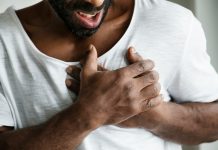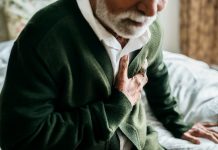
Scientists from Boston College outline the most reported symptoms of various cardiovascular diseases (CVDs), noting that men and women often experience different symptoms.
Cardiovascular disease is the leading cause of death in the U.S. and around the world.
It comprises several conditions, including 6 reviewed in this scientific statement: heart attack, heart failure, valve disease, stroke, heart rhythm disorders, and peripheral artery and vein disease.
Heart attack
Heart attack is one of several conditions that falls under the broad category of acute coronary syndrome (ACS), a term that refers to any heart condition caused by sudden loss of blood flow to the heart.
The most frequently reported symptom of ACS, particularly heart attack, is chest pain, often described as pressure or discomfort, and it may radiate to the jaw, shoulder, arm or upper back.
The most common co-occurring symptoms are shortness of breath, sweating or a cold sweat, unusual fatigue, nausea and lightheadedness.
These additional symptoms have often been referred to as “atypical,” however, a recent American Heart Association presidential advisory explains that this label may have been due to the lack of women included in the clinical trials from which the symptom lists were derived. Women are more likely than men to report more symptoms in addition to chest pain.
Heart failure
Shortness of breath is a classic symptom of heart failure and a common reason that adults with heart failure seek medical care.
However, early, more subtle symptoms should be recognized as signs to consult with a health care professional.
These symptoms may include gastrointestinal symptoms such as upset stomach, nausea, vomiting and loss of appetite; fatigue; exercise intolerance (related to fatigue and shortness of breath); insomnia; pain (chest and otherwise); mood disturbances (primarily depression and anxiety); and cognitive dysfunction (brain fog, memory problems).
Women with heart failure report a wider variety of symptoms, are more likely to have depression and anxiety, and report a lower quality of life compared with men with heart failure.
Just like with heart attack, women are more likely than men to report different symptoms.
In heart failure, women report nausea, palpitations and digestive changes, as well as higher intensity levels of pain (in other areas of the body, not just chest pain), swelling and sweating.
Valve Disease
Heart valve disease is a common cause of heart failure and shares the symptom of shortness of breath.
Problems with heart valves—the leaflet-like structures that control blood flow between the heart’s chambers—include narrowed or stiffened valves (stenosis), valves that close improperly (prolapse), allowing blood to flow backwards (regurgitation) or improperly formed valves (atresia).
In mild cases of valve disease people may have no symptoms for years, then develop progressively more symptoms similar to those associated with heart failure.
Valve disease can also cause high blood pressure in the lungs, or pulmonary hypertension. One of the most serious and common forms of valve disease is aortic stenosis, which occurs when the aortic valve narrows and restricts blood flow from the heart.
Women with aortic stenosis more frequently report shortness of breath, exercise intolerance and physical frailty than men, and they are more likely to have lower scores on a standard classification system for heart failure, known as the New York Heart Association Functional Classification.
Men with valve disease are more likely to report chest pain than women with valve disease.
Stroke
A stroke occurs when a blood vessel to the brain is blocked or bursts and typically causes recognizable symptoms that prompt emergency help.
To recognize stroke symptoms requiring immediate medical attention, the American Stroke Association recommends everyone remember the acronym F.A.S.T. for Face drooping, Arm weakness, Speech difficulty, Time to call 9-1-1.
Other symptoms of stroke are confusion, dizziness, loss of coordination or balance and visual changes. Recognizing stroke symptoms is critical since immediate treatment may help prevent or reduce the chance of long-term disability or death.
Women experiencing a stroke are more likely than men to have other, less familiar symptoms in addition to the common ones. These symptoms include headache, altered mental state, coma or stupor.
A stroke may also impair thinking, which may, in turn, impact the individual’s ability to recognize new or worsening symptoms.
After a stroke, some symptoms may linger and require continued care whether these symptoms require rehabilitation or become disabilities.
Post-stroke screening should include assessment for anxiety, depression, fatigue and pain. Post-stroke pain may take months to develop, with most reports occurring at 4–6 months after a stroke.
Rhythm disorders
Rhythm disorders, called arrhythmias, are often described as the feeling of an abnormal heartbeat or palpitations that may be irregular, fast, fluttering or halting.
Other symptoms include fatigue, shortness of breath and dizziness, all of which are shared with other cardiovascular diseases.
Less commonly, chest pain, dizziness, fainting or nearly fainting, and anxiety may occur in some people with heart rhythm disorders.
Women and younger adults with rhythm disorders are more likely to experience palpitations, while men are more likely to experience no symptoms.
Older adults are more likely to experience either uncommon symptoms or no symptoms. Differences in symptoms have also been found among people from diverse racial and ethnic group.
Data indicate Black adults report experiencing more palpitations, shortness of breath, exercise intolerance, dizziness and chest discomfort in comparison to people who are Hispanic or white.
Vein and artery disease
Peripheral artery disease, or PAD, affects the arteries in the lower extremities leading to reduced blood supply to the legs.
People with PAD may have no symptoms or may develop the classic symptom of claudication, which is a pain in one or both calf muscles that occurs while walking and subsides with rest.
However, pain in other parts of the legs and in the feet and toes are the most common symptoms of PAD rather than calf pain.
PAD with symptoms is associated with an increased risk for heart attack and stroke, with men at higher risk than women.
“Measuring vascular symptoms includes assessing the quality of life and activity limitations, as well as the psychological impact of the disease,” said Jurgens.
“However, existing measures are often based on the clinician’s appraisal rather than the individual’s self-reported symptoms and severity of symptoms.”
Depression occurs frequently among people with PAD, especially women and people who are elderly or from diverse racial and ethnic groups. Depression is also more likely to occur among people with more severe PAD.
Peripheral vein disease (PVD), like PAD, may cause no symptoms, or it may cause leg pain.
Typical leg-related symptoms include leg pain and achiness, heaviness or tightness in the legs, fatigue, cramping, restless legs syndrome and skin irritation.
In one study, adults younger than age 65 were more likely than older adults to report pain, heaviness, achiness and fatigue. Symptoms of vein disease sometimes occur even when there are no visible signs of the condition.
Sex differences in vein and artery disease are mainly seen among those with PAD. Women are more likely to report pain in other places than the calf muscle or no symptoms at all.
Women’s symptoms are often complicated by the mistaken belief that PAD is more common among men or that the symptoms are confused with those of other common conditions such as osteoarthritis.
PAD is also more likely to progress quickly in women and affect the quality of life.
Other factors that influence symptoms
National survey data shows that people with cardiac disease have about twice the rate of depression compared to people without any medical condition (10% vs. 5%).
A 2014 American Heart Association scientific statement suggested depression should be considered a risk factor for worse outcomes after an acute coronary syndrome event or diagnosis.
The current statement highlights that people with persistent chest pain, people with heart failure, as well as stroke survivors, and people with peripheral artery disease commonly, have depression and/or anxiety.
In addition, cognitive changes after a stroke may affect how and whether symptoms are experienced or noticed.
The writing group advises regular assessments of cognitive function and depression levels throughout the course of any cardiovascular disease because they have a strong influence on a person’s ability to detect symptoms and any changes in their condition.
If you care about heart health, please read studies about new way to prevent heart attacks, strokes, and common drug for heart disease may reduce COVID-19 risk.
For more information about heart health, please see recent studies about a big cause of congenital heart disease, and results showing this food could help prevent recurrent heart disease.
The research was published in Circulation and conducted by Corrine Y. Jurgens et al.
Copyright © 2022 Knowridge Science Report. All rights reserved.



